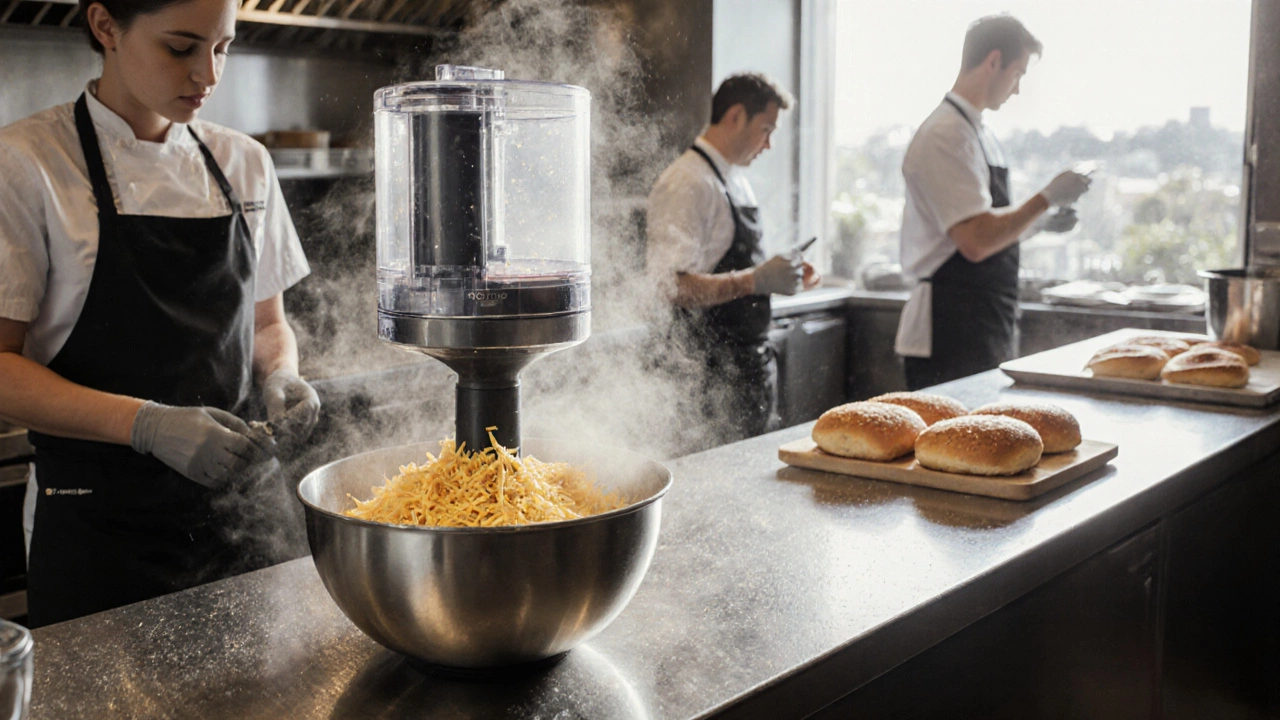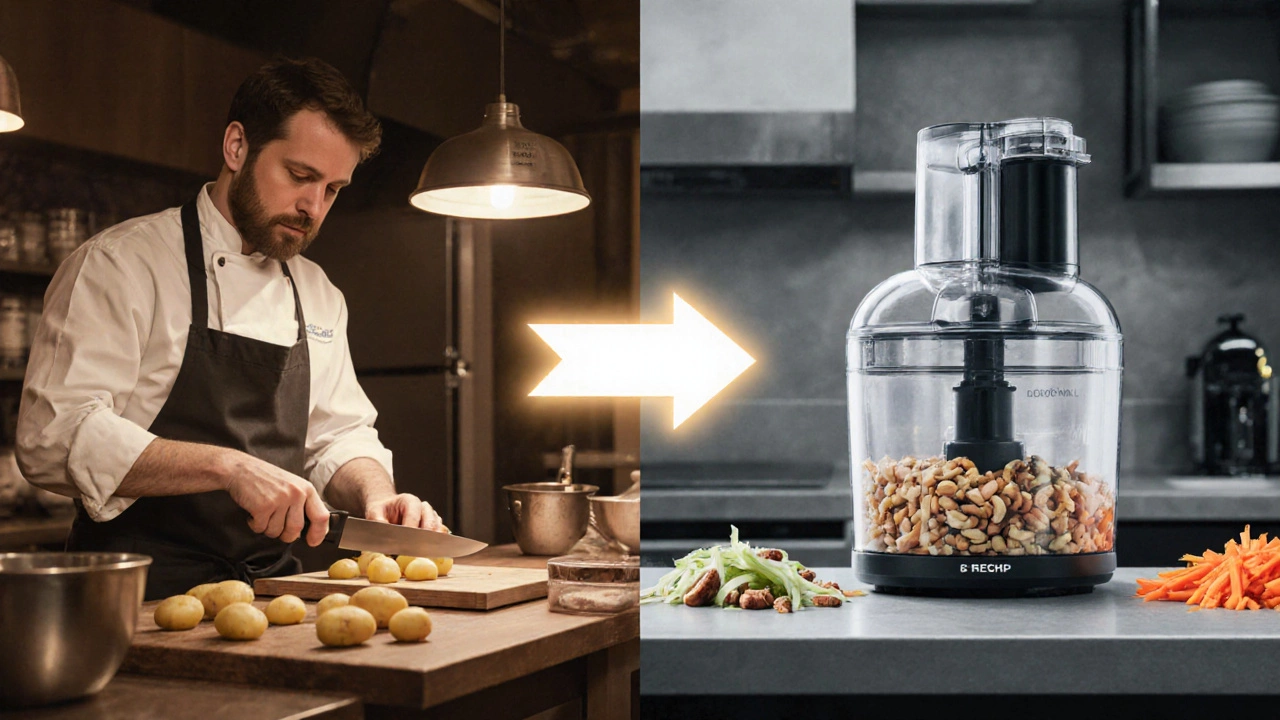
Restaurant Food Processor Savings Calculator
How Much Time & Money Can You Save?
Calculate labor savings when using a commercial food processor versus manual preparation.
Your Results
Time saved: 0 minutes
Cost saved: $0.00
Based on your restaurant's operations
Ever watched a chef chop onions in seconds, blend soup smooth as silk, or shred cheese in a flash? That’s not magic-it’s a food processor. And yes, restaurants use them. But not every kitchen runs the same way. Some chefs swear by them. Others avoid them like a broken blender. So what’s the real story behind food processors in professional kitchens?
Food Processors Are Everywhere-Just Not Always Visible
If you think restaurants only use knives and hands, you’re missing half the picture. In high-volume kitchens-think fast-casual chains, diners, or even busy fine-dining spots-food processors are silent workhorses. They don’t get spotlight moments on TV cooking shows, but they’re running behind the scenes, every day.At a suburban breakfast spot in Sydney, the team uses a commercial food processor to shred 20 kilos of cheese every morning. That’s 400 servings. Doing that by hand? Two people would spend 90 minutes on it, and their wrists would be screaming. With a machine? Five minutes. Clean-up? Another three. That’s time saved to prep fresh salsa, toast buns, or greet customers.
Even upscale restaurants rely on them for consistency. A chef making a signature carrot soup doesn’t want each batch to taste different because someone chopped carrots unevenly. A food processor delivers uniform pieces every time. That’s not laziness-it’s quality control.
What Do Restaurants Actually Use Them For?
It’s not just chopping. Food processors in professional kitchens do jobs no one thinks about until they’re gone:- Grinding meat for burgers or sausages-fresh, no additives, controlled fat ratio.
- Blending sauces like pesto, aioli, or curry pastes in seconds.
- Shredding vegetables for slaws, hash browns, or stir-fries.
- Mixing dough for pie crusts, pasta, or dumplings without overworking it.
- Processing nuts into butter or fine meal for gluten-free baking.
- Prepping garnishes like finely chopped herbs or pickled onions.
One owner of a Thai restaurant in Melbourne told me they use their processor to grind fresh lemongrass, galangal, and chilies into a paste. Hand-chopping those fibrous ingredients takes 20 minutes and leaves chunks. The machine? Four minutes. And the flavor? More even. More aromatic. More consistent across 50 orders a night.
Not All Restaurants Use Them-Here’s Why
But here’s the flip side: some restaurants avoid food processors entirely. Why?It’s about philosophy. In small, chef-driven places-especially those focused on traditional techniques or artisanal methods-hand-chopping is part of the craft. A French bistro might insist on hand-slicing potatoes for gratin because texture matters. A Japanese sushi bar won’t use a machine to cut fish; it’s about the angle, the blade, the feel.
There’s also cost and space. A commercial food processor isn’t cheap. Top models like the Robot-Coupe or KitchenAid Pro Series cost $800-$2,000. They take up counter space. And if your kitchen is already packed with mixers, slicers, and blenders, adding another machine isn’t always worth it.
Then there’s the noise. In quiet, upscale settings, the whirring of a food processor can be jarring. Some kitchens use them only during prep hours, tucked away in back areas.

Commercial vs. Home Food Processors: Big Differences
You might think a $100 home food processor does the same job as a restaurant one. It doesn’t.Commercial models are built like tanks. They have:
- More power-1,000 to 2,000 watts vs. 500-700 watts in home units.
- Heavy-duty blades that don’t dull after 10 uses.
- Larger bowls-up to 14 cups, sometimes more.
- Continuous operation-no overheating after five minutes.
- Easy cleaning-dishwasher-safe parts, no crevices for food to hide.
Brands like Robot-Coupe, Cuisinart Commercial, and Nemco are common in professional kitchens. You won’t see a Hamilton Beach or Ninja in a restaurant unless it’s a tiny café with one employee.
The Hidden Cost of Not Using One
Let’s say you run a sandwich shop. You make 150 sandwiches a day. Each one needs 2 tablespoons of pickled red onions. That’s 30 tablespoons. A food processor can shred a whole red onion in 15 seconds. You need three onions. Total prep time: under a minute.Do it by hand? 3 minutes per onion. That’s 9 minutes. Multiply that by 7 days a week: 63 minutes a week. That’s over an hour of labor you could spend on customer service, cleaning, or restocking.
And that’s just onions. Add garlic, ginger, herbs, cheese, nuts, and you’re talking hours saved per week. In the food industry, time is money. Labor costs are rising. Food processors aren’t a luxury-they’re a tool to stay profitable.

What About Food Safety and Cleanliness?
Some people worry: machines spread bacteria. But that’s not how it works. In fact, commercial food processors are easier to clean than knives and cutting boards.Restaurants follow strict HACCP guidelines. After each use, bowls, blades, and lids are washed, rinsed, and sanitized. Most units have parts that snap apart easily. A knife blade? You have to clean every crevice by hand. A processor bowl? Pop it in the dishwasher. Done.
Plus, fewer hands touching raw ingredients means less cross-contamination risk. A single person processes 10 kilos of carrots. No one else touches them. That’s safer than five people chopping separately.
Real Kitchen Example: A Sydney Café’s Routine
At The Daily Grind in Bondi, they start prep at 5 a.m. Here’s how their food processor fits in:- 5:15 a.m.-Shred 10 kilos of cheddar for breakfast melts.
- 5:30 a.m.-Blend cashews into vegan cheese sauce.
- 5:45 a.m.-Process roasted red peppers for bruschetta topping.
- 6:15 a.m.-Grind almonds for gluten-free pancake mix.
- 7:00 a.m.-Clean the machine and move to next task.
That’s 45 minutes of prep done in under an hour. Without the processor? They’d need an extra staff member just for chopping. And they’d still be behind.
So, Do Restaurants Use Food Processors?
Yes. But not all of them. It depends on volume, style, budget, and philosophy.Fast-casual, diners, catering companies, bakeries, and high-volume kitchens? Almost always. They’re essential tools.
Small, traditional, or ultra-luxury spots? Maybe not. They prioritize handcrafted methods-even if it costs more time.
The truth? Food processors aren’t replacing chefs. They’re helping them. They free up time, reduce waste, and ensure consistency. In an industry where margins are thin and demands are high, that’s not a shortcut. It’s smart work.
If you’re thinking about opening a restaurant, don’t ask, ‘Should I get a food processor?’ Ask: ‘What tasks am I doing by hand that could be done faster-and better-with a machine?’
Chances are, the answer is more than you think.